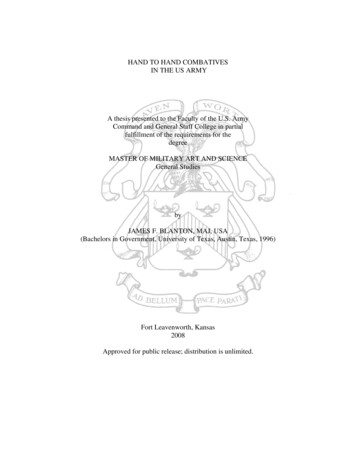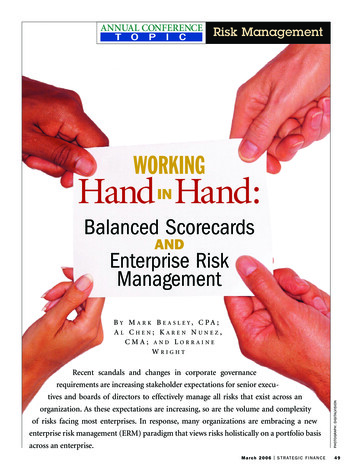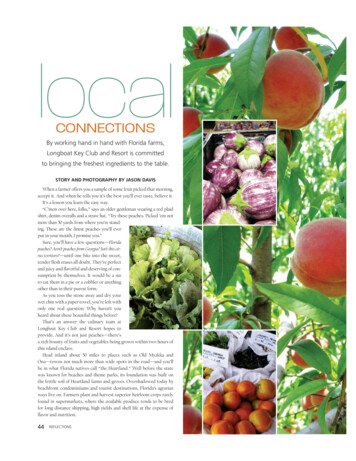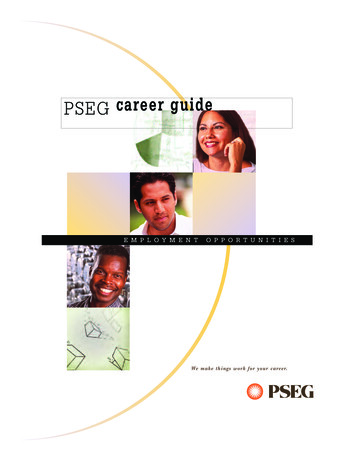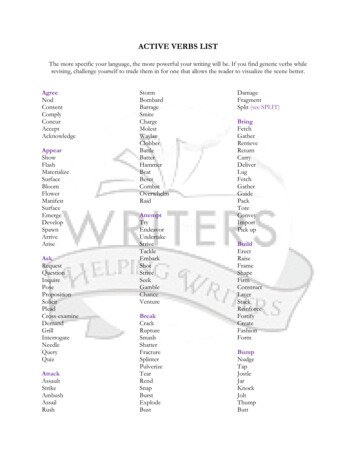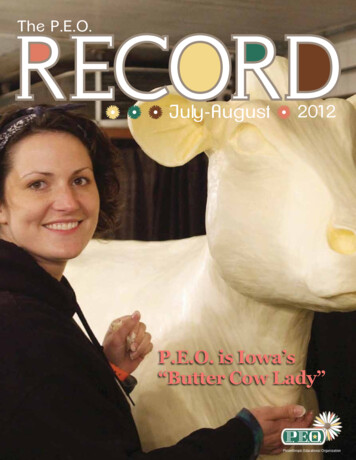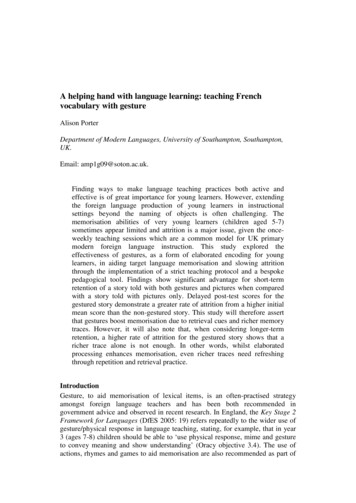
Transcription
A helping hand with language learning: teaching Frenchvocabulary with gestureAlison PorterDepartment of Modern Languages, University of Southampton, Southampton,UK.Email: amp1g09@soton.ac.uk.Finding ways to make language teaching practices both active andeffective is of great importance for young learners. However, extendingthe foreign language production of young learners in instructionalsettings beyond the naming of objects is often challenging. Thememorisation abilities of very young learners (children aged 5-7)sometimes appear limited and attrition is a major issue, given the onceweekly teaching sessions which are a common model for UK primarymodern foreign language instruction. This study explored theeffectiveness of gestures, as a form of elaborated encoding for younglearners, in aiding target language memorisation and slowing attritionthrough the implementation of a strict teaching protocol and a bespokepedagogical tool. Findings show significant advantage for short-termretention of a story told with both gestures and pictures when comparedwith a story told with pictures only. Delayed post-test scores for thegestured story demonstrate a greater rate of attrition from a higher initialmean score than the non-gestured story. This study will therefore assertthat gestures boost memorisation due to retrieval cues and richer memorytraces. However, it will also note that, when considering longer-termretention, a higher rate of attrition for the gestured story shows that aricher trace alone is not enough. In other words, whilst elaboratedprocessing enhances memorisation, even richer traces need refreshingthrough repetition and retrieval practice.IntroductionGesture, to aid memorisation of lexical items, is an often-practised strategyamongst foreign language teachers and has been both recommended ingovernment advice and observed in recent research. In England, the Key Stage 2Framework for Languages (DfES 2005: 19) refers repeatedly to the wider use ofgesture/physical response in language teaching, stating, for example, that in year3 (ages 7-8) children should be able to ‘use physical response, mime and gestureto convey meaning and show understanding’ (Oracy objective 3.4). The use ofactions, rhymes and games to aid memorisation are also recommended as part of
a Year 3 formative assessment strategy (Asset Languages and CILT 2010: 17).Recent research conducted in primary school classrooms in England (childrenaged 5-11) has noted that both teachers and children use and value physicalgesture to aid memorisation and visualisation in second language learning (Cable,Driscoll, Mitchell and Holmes 2010: 81, 86, 94 and 99). However, there seems tobe little empirical evidence exploring the nature of this strategy’s success oridentifying its possible limitations (Tellier 2008).This study’s fundamental premise is that gesture supports memorisation inlanguage learning through enhanced or elaborated processing and thereforecreates a more durable and more accessible memory trace for new language. Inpractical terms, such traces should result in higher recall (production) and lowerattrition (loss) of lexical items learnt with gestures as supports. The theoreticalframework for this paper will set out ideas relating to levels of processing inmemorisation (Craik and Lockhart 1972), a model of working memory (Baddeley2003) which posits the idea that visual and non-visual information can beprocessed simultaneously, and research relating to memorization of ‘eventsinvolving actions’ (Cohen, 1989: 60) which holds that enactment might enhanceaccessibility of traces (Cohen and Otterbein 1992: 118), is non-strategic (Cohen1981, 1983) and also creates more distinctive and richer traces (Bäckman andNilsson 1984, 1985). The multi-faceted role of gesture in language use will beacknowledged, and existing research relating to the idea that gestures can aidlanguage learning will be examined.BackgroundLevels of processingThe idea of levels of processing was encapsulated by Craik and Lockhart (1972)who posited that remembering was more about the residual ‘after-effects ofprocessing’ than hypothetical short- and long-term memory structures (Baddeley1997: 115). In this view, differing traces ‘persist for different lengths of time’:initial traces are ‘superficial and shallow’ (for example, physical or sensoryfeatures such as lines, pitch, brightness), but subsequent deeper processinginvolving perhaps pattern recognition and extraction of meaning can produce‘depth of processing’ which, in turn, leads to ‘more elaborate, longer lasting andstronger traces’ (Craik and Lockhart 1972: 675). Baddeley concludes thatstructure in memory (short- and long-term storage) is better defined by the levelof processing involved than by ideas relating to unitary ‘stores’. Short-termmemory is characterised by ‘maintenance rehearsal’ which holds information butdoes not transform it, whilst long-term memory is concerned with ‘elaborativerehearsal’ which increases the depth of encoding (Baddeley 1997: 116). He alsosuggests that the key to learning is organisation and consolidation (or processing),in other words, ‘what the subject does with the material to be remembered’(Baddeley 1997: 107) and that richer traces improve learning (Baddeley 1997:120-121). Hulstjin too asserts that ‘richness of encoding’ is widely accepted asleading to higher retention of lexical items (Hulstjin 2001: 270) but adds that richelaborate processing might not be enough and that new information must also bereactivated by rehearsal activity to produce a more lasting trace (Hulstjin 2001:269).
Multi-component working memoryFollowing Craik and Lockhart’s examination of memory from an input orencoding perspective, Baddeley and Hitch proposed a working memory modelwith three separate components which might support such memorisationprocesses. The model comprised: the central executive, the visuo-spatialsketchpad and the phonological loop which could deal simultaneously withdifferent kinds of input (Baddeley and Hitch 1974: 47-90). The visuo-spatialsketchpad could integrate spatial, visual and possibly kinaesthetic informationinto a unified and adaptable representation and the phonological loop facilitatesthe temporary storage (and refreshing) of auditory signals. Later research led tothe proposal of an episodic buffer linked to the central executive which, it wassuggested, would allow for the ‘binding together’ of information from the visuospatial sketchpad, phonological loop and long-term memory into a ‘unitaryepisodic representation’ (Baddeley 2000; Baddeley 2003: 203). The episodicbuffer has a role in long-term episodic learning through the supply and retrievalof information from the episodic long-term memory (Baddeley 2000: 421).Enactment and memoryIn addition to the possibility that levels of processing might affect memorisation,cognitive psychology research has identified and explored the ‘enactmentparadigm’ which, by obtaining different performance levels to those achievedthrough verbal-only memorisation, suggested a role for alternative memorisationrelated principles and laws (Nilsson 2000: 137). Whilst initial experimentstypically noted superior memory for enacted action phrases, i.e. instructionspresented with subject-performed tasks (SPTs) (Engelkamp and Zimmer 1985),other research has noted that merely observing or imagining enactment with realor imagined objects can positively affect recall (Kormi-Nouri 2000). Nilsson(2000: 144) concluded that enactment benefits do not appear to involve adding a‘specific motoric dimension’ to memory traces. Explanations for such effectsfocus, then, on encoding, processing and accessibility.Cohen (1981, 1983) suggested that memory for action events is non-strategic(evidenced by a lack of properties usually associated with word recall: primacy,age and levels of processing effects), and, as such, acted as an optimal form ofencoding. In this way, encoding was not reliant upon ‘deliberate strategies forremembering’ (Nilsson 2000: 137) and has, therefore, been suggested to be ofparticular use with both younger and learning-impaired learners (Cohen 1989).On the other hand, Nilsson and Bäckman (1989: 174-5 181) proposed qualitativedifferences in the memory processes for SPTs (compared with verbal tasks)postulating that SPTs involved both explicit and implicit memory componentsand both (or either) codes could be accessed depending on test conditions. It is,however, important to note that others (Kormi-Nouri 1995) consider the encodingof action events to increase the degree of self-involvement to such an extent thatencoding is ‘entirely strategic’ and facilitated by semantic integration (Nilsson2000: 139). In other words, enactment is a consciously applied memorisationtechnique.Memory for action events might also affect the nature of a memory trace.Enactment during encoding is believed to automatically involve multi-modalprocessing thereby yielding richer encoding (Bäckman and Nilsson 1984, 1985).Furthermore, motor encoding is reported to be more durable, more accessible and
‘highly resistant to forgetting’ (Knopf and Neidhardt 1989: 785). Richer and moredistinctive traces are easier to find at recall, and enactment contributes to ‘tracedistinctiveness’, setting a trace ‘marker’ which aids recall (Cohen and Otterbein1992). Engelkamp and Zimmer (1989) postulated that SPTs (over visual imageryand watching) promoted superior recall due to a motor system whichcomplemented the verbal and imaginal system. Enactment sufficiently engagedthe motor system which contributed to a ‘particularly good memory trace’ (1989:153). It has further been suggested that, in line with the Dual Coding Theory ofPaivio (1971, 1986) which holds that two modalities (visual/verbal) are betterthan one, three modalities (visual/verbal/motor) should operate more effectivelythan two (Cohen 1989). The particular benefits of enactment have also beenlinked to item-specific (rather than relational) motor encoding evidenced by apositive effect for enactment on recognition (Zimmer and Engelkamp 1989) anddistinctive motor encoding where an event is ‘registered in a multidimensionalrepresentational space’ (Nilsson 2000: 138).Furthermore, enactment might also aid retrieval. In other words, as episodic(or event) memory traces comprise bundles of attributes, generation of just onecomponent of a multi-component trace (i.e. an already encoded enactmentcomponent) will facilitate retrieval of the whole trace including verbal content(Cohen and Otterbein 1992). Nevertheless, it is important to note that whilstenactment during encoding improves memory performance, enactment duringretrieval is considered to be of limited importance (Kormi-Nouri and Nilsson2001: 100).Gesture and languageGullberg (2006) recognises two key areas which highlight the relevance ofgesture in studies of second language acquisition. Firstly, gesture is seen as partof language itself; that is to say, as a developing system for learners to acquire inboth production and comprehension terms. Secondly, it is seen as a tool forlanguage acquisition which assists the learner in a number of ways, including:handling expressive difficulties, cross-linguistic (L1/L2) influence and planningand processing. This study will focus on the last of these; more specifically,treating gestures as a means of enhancing memorisation through deeperprocessing and richer memory traces.Whilst several frameworks have been proposed for classifying gesture types,Gullberg (2006) notes two distinctive and universal gesture categories: ‘emblems’that are codified and conventional, and ‘representational or rhythmic gestures’that are non-standard and spontaneous. McCafferty and Stam (2008: 6) seeemblems as ‘filling a grammatical slot’ in language production, and spontaneousgestures as ‘thinking-for-speaking’ - the interaction between gesture and theorganisation of thought to support linguistic encoding. Five key gesture typeshave been noted by McNeill (1992: 12-18) and are summarised in Table 1. Whilstit is possible that a gesture may belong to multiple categories (McCafferty andStam 2008: 9), this study will attempt to classify each gesture type used in linewith McNeill’s well-known framework.
Gesture present action or object.Close formal relationship tothe semantic content of speech.Pictorial.Relate to an abstractionIdentify objects and eventseither concrete or abstract.Tie together themes temporallyseparated in discourse.Emphasise continuities.a. Meta-level of discourseb. Meta-linguistic – children 5ExampleCup to mouth drinkBall shape a whole ideaThumb over shoulder pastReplication of gesture totake up a point previouslyexpressedNodding to enumerate listsAccompanying syllablestructureTable 1: Gesture classification system after McNeill (1992: 12-18)Gesture and memorisationIn the light of research concerning motoric processing, enactment and levels ofprocessing, it seems possible that gestures could act as a form of elaboratememory traces, enhancing memorisation and, ultimately, language learning. Inthis way, an ‘enhanced plus teacher-led’ presentation of language (e.g. supportedby both visuals and gestures) coupled with explicit instructions to learners toreplicate those gestures would increase the likelihood of the learner manipulatingdepth of processing. This possibility is supported by empirical evidence relatingto both first language acquisition and second language learning.Gesture and L1 acquisitionGestures occurring with speech have been shown to facilitate sentence memoryby listeners. Early research explored the mnemonic effect of experimenterperformed gesture with first semester university students (Cohen and Otterbein1992). Meaningful gesture was deemed to significantly affect memorisation ofunconnected L1 sentences in both selective and cued recall conditions, whencompared with gestures not related to meaning. These research
A helping hand with language learning: teaching French vocabulary with gesture . Alison Porter . Department of Modern Languages, University of Southampton, Southampton, UK. Email: amp1g09@soton.ac.uk. Finding ways to make language teaching practices both active and effective is of great importance for young learners. However, extending the foreign language production of young
